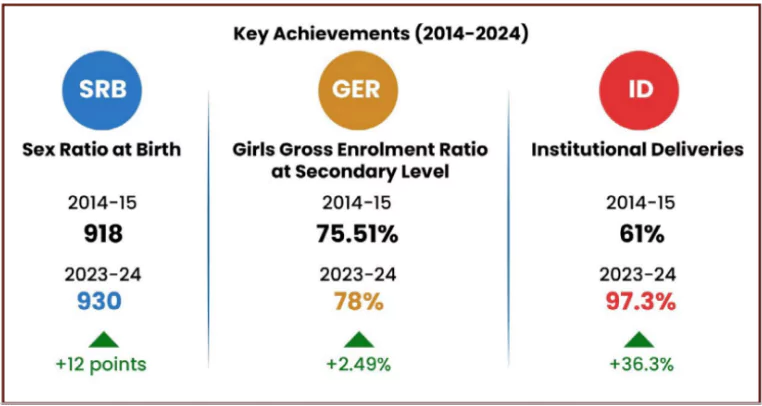Celebrations marking 10 years of the BBBP will continue from January 22 to March 8, International Women’s Day.
- The event will also showcase the launch of Mission Vatsalya for development and child protection priorities and Mission Shakti portals for women’s safety, security and empowerment.

About BBBP Scheme
- It was launched on January 22, 2015, in Panipat, Haryana, by the Prime Minister as a flagship Scheme.
- Aim: To combat sex-selective abortion and improve the declining child sex ratio, which was 918 girls per 1,000 boys in 2011.
- Collaborative Initiative:
- Jointly implemented by the Ministry of Women and Child Development, Ministry of Health and Family Welfare, and Ministry of Education.
- Later, the Ministry of Skill Development and Entrepreneurship and the Ministry of Minority Affairs were added as partners.
- Type of Scheme: Centrally sponsored, with no provision for Direct Benefit Transfer (DBT) or the creation of capital assets.
- Allocation for Districts Based on Sex Ratio at Birth (SRB)
- SRB ≤ 918: ₹40 lakh per year.
- SRB 919–952: ₹30 lakh per year.
Enroll now for UPSC Online Course
Key Terms Related to BBBP Scheme
- Sex Ratio at Birth (SRB): Represents the number of female live births per 1,000 male live births during a specific period.
- A higher SRB reflects reduced gender-based discrimination and the curbing of female foeticide.
- Gross Enrolment Ratio (GER): Indicates the percentage of students enrolled in a specific level of education compared to the population of the official age group for that level.
- Measures the accessibility and inclusiveness of education for all children, especially girls.
- Institutional Deliveries: Refers to childbirths conducted in medical institutions like hospitals or clinics under skilled health professionals.
- Reduces maternal and neonatal mortality by ensuring access to emergency care during childbirth.
- ANC (AnteNatal Care) Registration: Refers to the registration of pregnant women within the first trimester for medical check-ups and monitoring.
- Ensures early screening, nutritional support, and identification of pregnancy-related risks.
|
-
- SRB > 952: ₹20 lakh per year.
- Inclusion in Mission Shakti: BBBP is part of the ‘Sambal’ vertical of Mission Shakti, which focuses on women’s safety, security, and empowerment.
-
- Mission Shakti has two sub-schemes:
- Sambal: Safety and Security
- Samarthya: Empowerment
Eligibility Criteria for Beneficiary Under the Scheme
- The family should have a girl child below 10 years of age.
- There should be a Sukanya Samriddhi Account or SSA which has been opened in any Indian bank, in the name of the girl child in the family.
- The girl child should be a resident Indian.
- NRI citizens do not possess eligibility for the BBBP scheme.
Main Objectives of BBBP
- Improve Sex Ratio at Birth (SRB): Aim to improve SRB by 2 points every year.
- Enhance Institutional Deliveries: Sustain institutional deliveries at 95% or above.
- Increase Enrolment and Skilling: Achieve a 1% annual increase in secondary education enrolment and skilling of girls and women.
- Reduce Dropout Rates: Minimize dropout rates at secondary and higher secondary levels.
- Promote Menstrual Hygiene Awareness: Raise awareness about safe menstrual hygiene management (MHM).
Check Out UPSC CSE Books From PW Store

Achievements of the Scheme
- Sex Ratio at Birth (SRB): Improved nationally from 918 in 2014-15 to 930 in 2023-24.
- Gross Enrollment Ratio (GER): Increased from 75.51% in 2014-15 to 78% in 2023-24.
- Institutional Deliveries: Rose from 61% in 2014-15 to 97.3% in 2023-24.
- Maternal Mortality Rate (MMR): Reduced from 130 deaths per lakh live births in 2014 to 97 deaths in 2023.
- Infant Mortality Rate (IMR): Declined from 39 deaths per 1,000 live births to 28 during the same period.
Ready to boost your UPSC 2025 preparation? Join PW’s UPSC online courses today!
![]() 23 Jan 2025
23 Jan 2025



